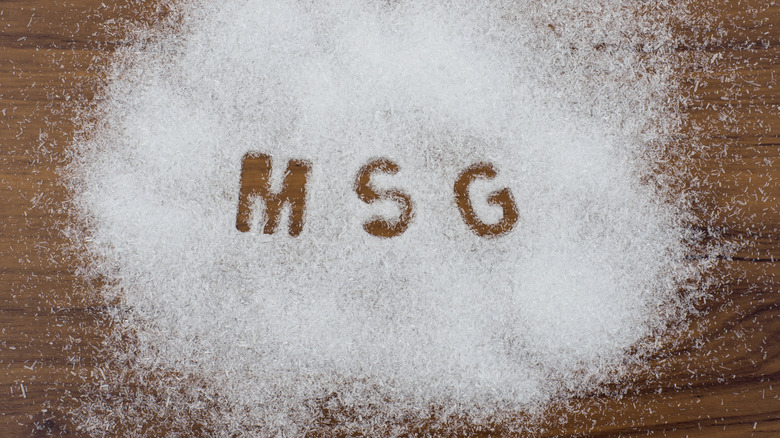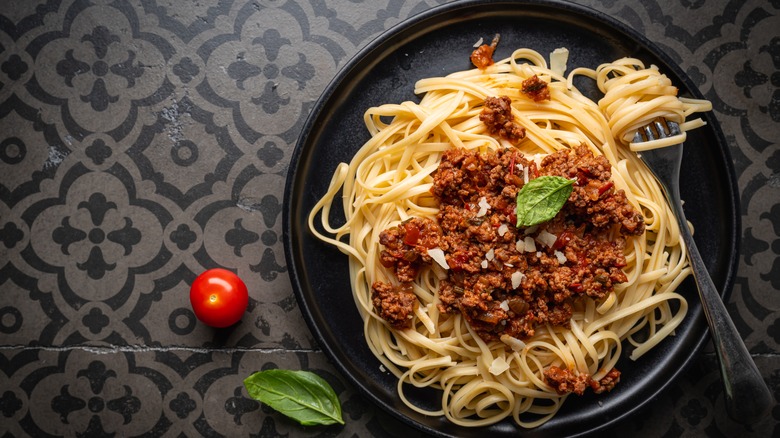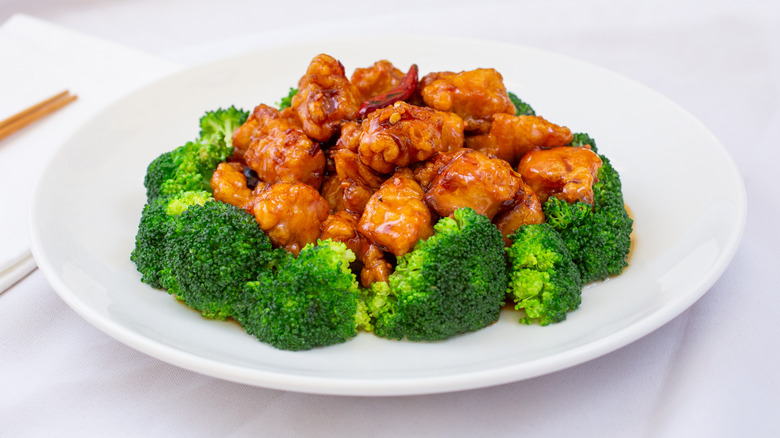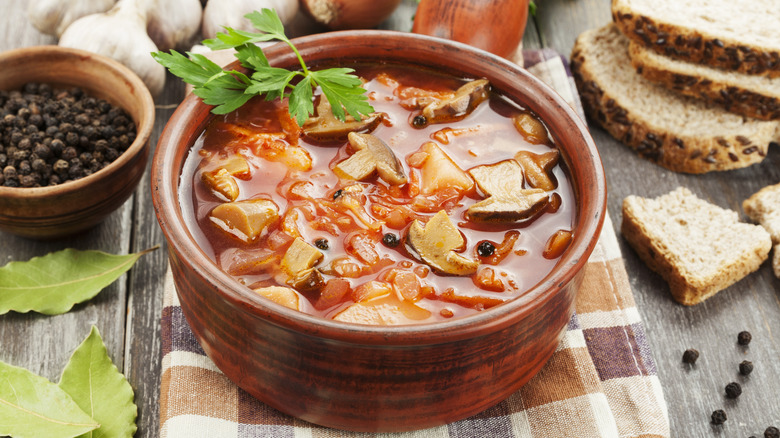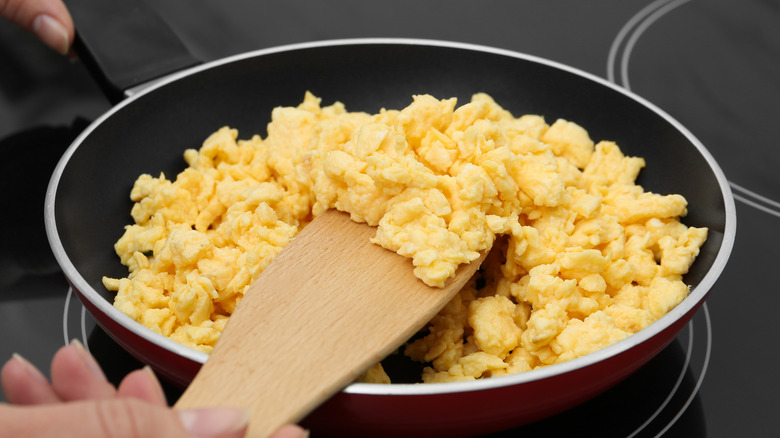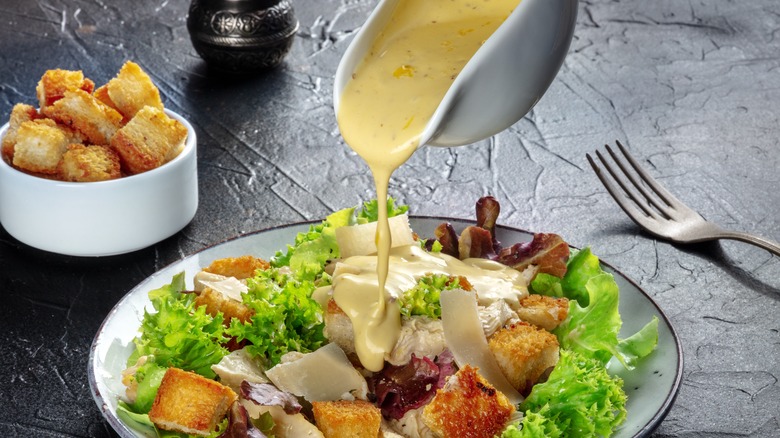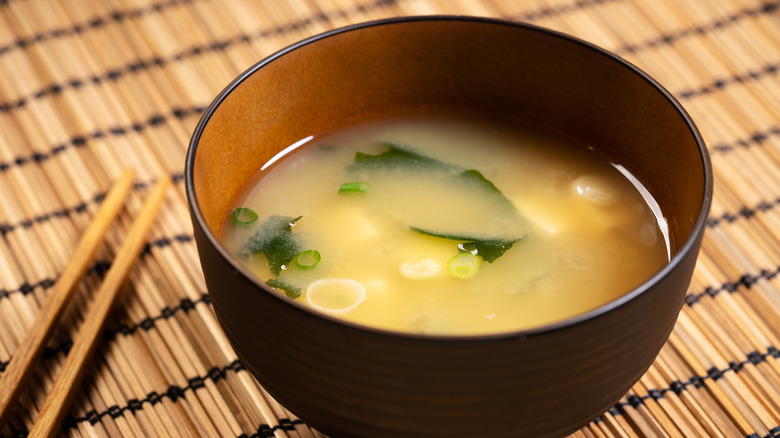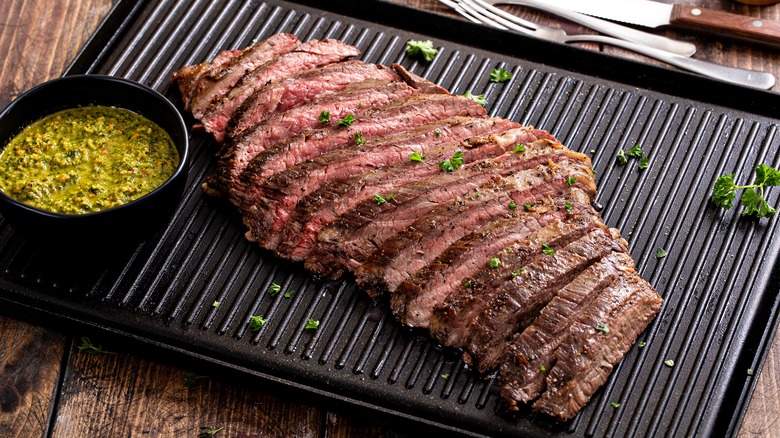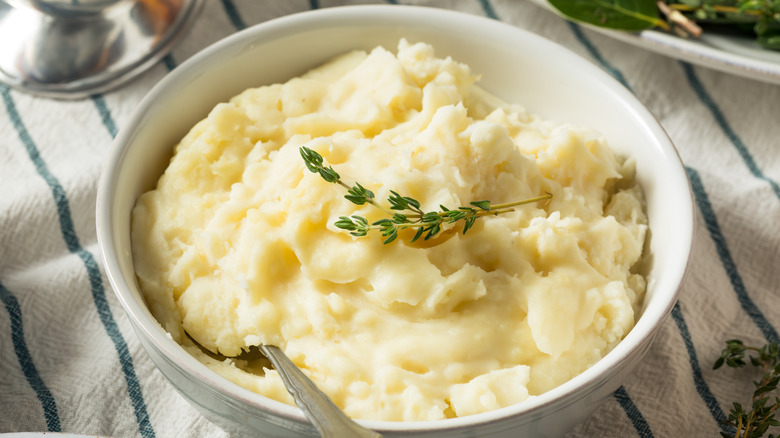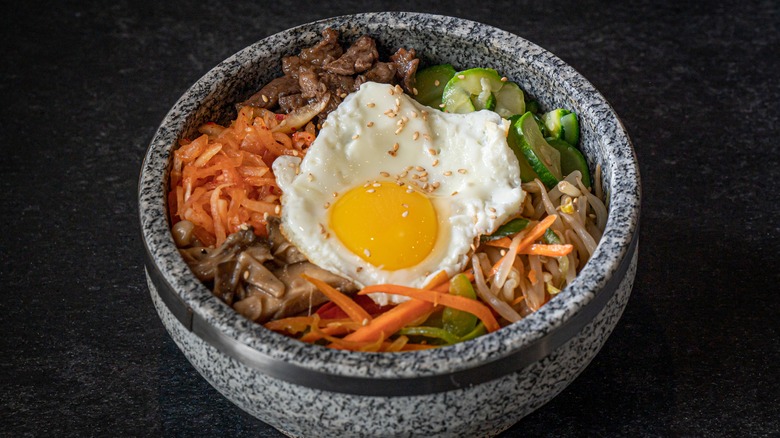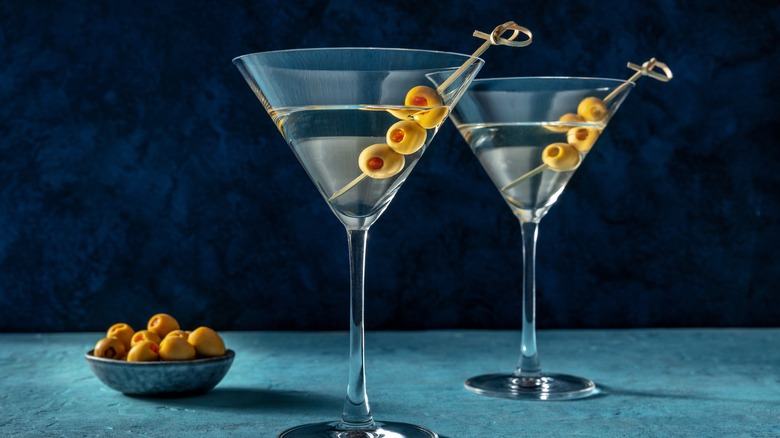The 11 Absolute Best Ways To Use MSG
At least two things are true about MSG: it makes things taste delicious and it's controversial. Kikunae Ikeda, a biochemistry professor at Tokyo Imperial University, came up with the idea that became MSG when he asked his wife what it was that made her simple vegetable and tofu broth so delicious. She told him the savory flavor came from "kombu," a type of seaweed.
Ikeda set about isolating the element in the kombu that it held in common with tomatoes, mushrooms, cheese, and meat: a taste beyond sweet, sour, salty, and bitter. Ikeda dubbed this fifth flavor umami (Japanese for "savory" or "deliciousness"). Per the Washington Post, Ikeda bonded this umami element with sodium resulting in "monosodium glutamate" (or MSG). The result was a powder that could be used like salt and can now (according to The Takeout) be found in just about any grocery store.
This popularity also led to various MSG myths and controversy (per Colgate Magazine) but MSG has proven to have remarkably resilient staying power. According to the FDA, MSG is deemed to be "generally recognized as safe." Combine that with the fact that many of America's greatest chefs love using MSG. So let's explore the best things that you, like many of those chefs, can make using MSG.
Tomato sauce
Tomatoes are naturally high in umami from glutamates, which is to say, naturally occurring MSG. As Delish Knowledge points out, this is true of a lot of vegetables besides tomatoes, including onions, asparagus, soy (and soy products like miso paste), broccoli, peas, beets, and mushrooms. The umami in each of these ingredients leads to at least one thing: deliciousness. And the more, the better.
As The Washington Post explains, adding MSG to dishes containing these natural glutamates — including tomato dishes — enhances that deliciousness by layering different glutamates, one atop the other. So, which type of tomato dish should you make with MSG? Any kind of pasta sauce would be a good choice, but Bolognese sauce might be the best, as chef J. Kenji López-Alt points out in his book, "The Food Lab." The key to his recipe for the ultimate Bolognese is layering multiple glutamate, including Marmite. As The Washington Post points out, López-Alt is a big fan of Marmite, and perhaps you should be too.
General Tso's chicken
Much of the lore of MSG in America — both for worse but possibly a bit for better — revolves around Chinese food. And if there is one dish that (rightly or wrongly) is the poster child for that, it would probably be General Tso's chicken. A dish nearly unknown in China, General Tso's chicken was created by Peng Chang-kuei, chef to the Premier of the Republic of China (aka Taiwan). Peng originally created the dish using classic Hunanese flavors before he left Taiwan for America. By the time Peng arrived in New York, his dish had already arrived in the U.S. Beyond that, though, the dish had morphed into one featuring the sweet flavors that mark the most popular Chinese (and "Hunanese") dishes in America. That now-familiar version significantly reflects America's national sweet tooth (via Rachel Laudan).
There was another significant difference between Peng's original dish and the ubiquitous American-Chinese General we know and love: MSG. Could General Tso's chicken be made without MSG? Sure. But why? The MSG underlines the umami of the soy and hoisin sauces in the most typical recipes and is, quite likely, one of the reasons that this American-Chinese take on Peng's original dish named after a Hunanese general has become America's favorite "Chinese" dish.
Mushroom soup
Mushrooms, like tomatoes, are high in naturally occurring glutamate (via SF Gate). So, again, as Cafe Meeting Place explains, it's all about layering glutamates. The synergistic effect of combining those ingredients is the key. One is good. More than one is better. And a dash of MSG added to those naturally occurring glutamates can take a dish over the top.
Go back to the origins of MSG by going in an Asian direction with a clear Japanese mushroom broth, or maybe use miso to add another layer of umami to the mushrooms. Or perhaps go with an Eastern European style borscht soup featuring the umami of both dried porcini mushrooms and beautiful red or yellow beets. Garnish the dish with julienned beet greens to double down on those beets while adding another color to the dish.
Either way, a dash of MSG will heighten the savory deliciousness of the star ingredients.
Black garlic and huitlacoche risotto
Risotto is a comfort food for adults. Even making the dish — calming, constant stirring, sensing the need for a bit more stock here and a tad more wine for the pot (and the cook) — is a rhythm to another, better place. On its own, risotto is great. But add in some more glutamate, and it goes to another level.
Combine black garlic (which, according to Umami, is rich in umami) with umami-rich aged Parmesan cheese and huitlacoche (a Mexican corn fungus that is an umami bomb), and the result is a dish of deep and pure deliciousness. You'll enjoy the synergistic layering of different sources of umami, added to the inherent comfort of the risotto dish itself, as well as the dramatic black color resulting from the huitlacoche and the black garlic. These elements make this risotto both a weeknight hug of a dish and a dinner party showstopper that would not be out of place at a nice restaurant.
Scrambled eggs
Eggs and MSG are a natural combination, and, as The Washington Post points out, scrambled eggs, in particular, show just how MSG impacts flavor. As the umami that is MSG comes in powdered form, you can calibrate the exact amount necessary to achieve the deepening, highlighting more savory and delightfully complex flavors the MSG pulls out of the eggs. MSG makes everything taste more like itself, and eggs are no exception (via Prevention). In many ways, MSG is to savory food what sugar is in the world of sweets.
Some simple techniques can make your play with scrambled eggs and MSG more fruitful. Whisking eggs before cooking is a critical step in breaking apart the proteins. Not doing so risks rubbery eggs. Doing so with a fork rather than a balloon whisk improves the odds of a fluffy and soft plate of scrambled eggs.
The whisking step also offers the perfect opportunity to add MSG to the eggs. Start with just a bit of powder, scramble up and cook a small test batch, and taste to see what the MSG has done for the eggs. Add a dash more and see where it takes them. Add more if you want more umami or even if you just want to see where that MSG can take you.
Caesar salad dressing
An argument could be made that Caesar salad is America's favorite salad. It is all about a handful of great ingredients juxtaposed artfully in just the right proportions. The crisp freshness of romaine lettuce and the big, garlicky crouton may be the first things you notice, but the dressing is the real knockout ingredient.
The thing that makes a Caesar dressing so good is umami. The sources of that umami are twofold: Parmesan cheese and anchovies. Originally, the anchovy element was not in the form of the fish themselves but rather their incorporation as an ingredient in Worcestershire sauce. But that changed long ago, and those little fish became a critical Caesar dressing ingredient in their own right in today's Caesar salad classic. The change, of course, was intended to boost the dressing's umami quotient.
And there is no good reason not to go one step further by layering a bit of MSG over the umami from the anchovies in the dressing. Add a sprinkle or two of MSG, and it will take your salad over the top.
Miso soup
Take a trip back to the origins of Professor Ikeda's discovery of umami and MSG with a humble, simple dish like miso soup. The key ingredients in classic Japanese miso soup are dashi (the essence of which is umami, according to Google Arts & Culture) and miso paste. Miso is a paste based on fermented soybeans made by mixing soybeans with various grains and koji (a mold perhaps best known for making soy sauce and sake). Miso paste is also a natural source of glutamate.
It is the naturally occurring umami in miso soup that makes it so delicious, just as it did the soup that Ikeda's wife made. And the natural umami from the miso paste and dashi can be enhanced — indeed heightened — by adding even a small sprinkle of powdered MSG into the soup. Once again, layering the different umami sources — adding a bit of MSG on top of the miso paste and dashi — results in a greater depth of flavor.
Grilled flank steak
Steak, indeed beef and meat in general, are excellent sources of umami. As The Stone Grill points out, umami is created in the cooking process as steak breaks down. Many of today's top chefs fully understand and take advantage of that: Grant Achatz, of Chicago's groundbreaking Alinea, for one. Andy Ricker of Portland's late, lamented Pok Pok and Roy Choi of Los Angeles' Kogi BBQ for two more. There is no shortage of them that would happily testify to that. And they are not close to alone. The simple fact is that it is the umami resulting from the steak cooking process that makes us love steak! And great chefs know that.
So, take a powerful cut of beef like a flank steak or a picanha and marinate it in an Asian inflected marinade of soy (for a bit more umami), sherry, and honey and add in some MSG (for still more umami). The result will have at least two benefits: amped-up flavor and greater tenderness. A quick trip to the grill and dinner is served.
Mashed potatoes
While mashed potatoes might not seem to be among the most obvious candidates for the MSG treatment, perhaps it is time to give that a reevaluation. Mashed potatoes are a tailor-made umami delivery system. It's their buttery quality that helps mashed potatoes pair perfectly with umami sources, especially MSG.
The secret to why MSG works so well with mashed potatoes lies in the powdery glutamate's capacity to enhance salty and sour flavors, as The Washington Post explains. The MSG gloms onto those flavors and brings them alive. As with scrambled eggs, MSG (as opposed to naturally occurring glutamates in foodstuffs) is a particularly good choice for mashed potatoes because the powder format of MSG gives the cook an added measure of control and precision. Start with a little and add the MSG stepwise to your taste. Add an umami-rich bowl of mashed potatoes to a steak dinner, and you have the makings of a classic meal.
Bibimbap
Bibimbap is a classic Korean dish. Actually, it's a set of dishes in which a number of different vegetables (most commonly, sautéed) and marinated meats are arranged over perfectly cooked white rice and topped with a sunny side up egg. The name bibimbap itself directly describes the dish: It is a "bibim" (Korean for "mix") of various ingredients over "bap" (Korean for "rice"), per Go Go Hanguk.
Bibimbap is, of its nature, an opportunity to layer sources of umami. From the soy in the meat marinades to the vegetables themselves, bibimbap is naturally full of umami. Soy? Umami. Shiitake mushrooms? Umami. And the gochujang sauce: a big-time umami that, per Delish, "can boost the flavor and umami in nearly any dish."
Dolsot bibimbap, perhaps the most common version found in the United States, features a bowl of rice with meat and a bunch of fresh, marinated, and fermented vegetables. Typical ingredients in a bowl of dolsot bibimbap include vegetables like shiitake mushrooms, zucchini, carrot, spinach, and bean sprouts, along with beef marinated in a bulgogi-like sauce featuring soy, rice vinegar, honey, apple, and no shortage of garlic. Bibimbap, then, is already, of its nature,e a home for umami. Adding a little MSG to the rice will enhance the natural deliciousness and bring the umami in the dish up to another level.
Filthy martini
The martini is good. The dirty martini is better. Add some MSG and you have a martini that is absolutely filthy good. The classic martini recipe is both familiar and simple: some gin, some vermouth, and a dash of bitters. There is nothing wrong with it and so much that is right.
However, the classic martini is far from the only martini. James Bond's Vesper martini, from "Casino Royale," brings vodka to the party and (per Bond Lifestyle) substitutes Lillet for the vermouth. At the other end of the spectrum, the dirty martini (popularized by Franklin Delano Roosevelt, according to Spirits Beacon) operates on the principle that it would be a shame to relegate the olive to the role of garnish: bring on the olive brine.
The filthy martini, in turn, says to the dirty martini: "Don't send a boy to do a man's job." Oh, the olive brine is fine, but it needs some help. And MSG is just the man for that job.
